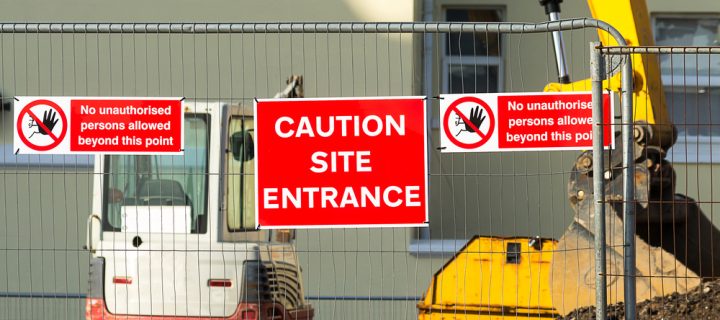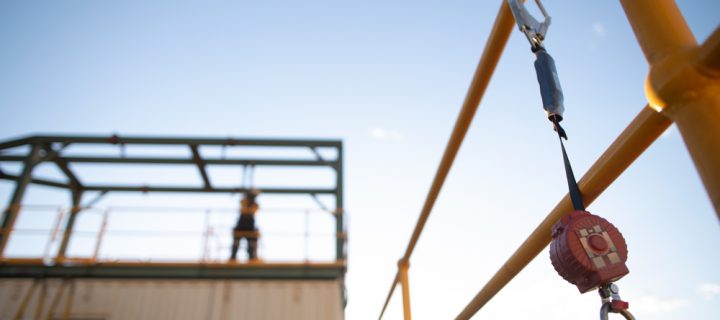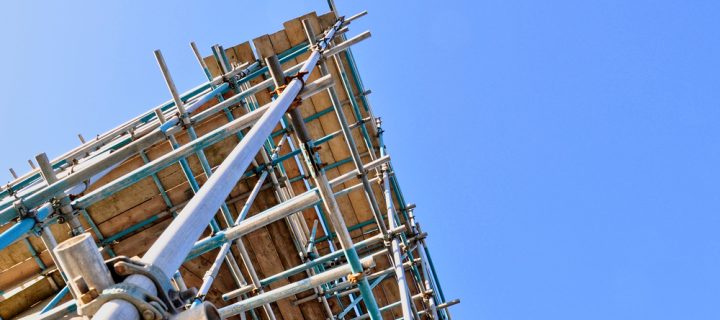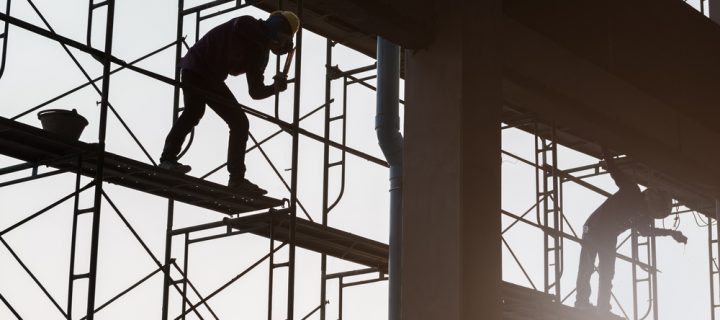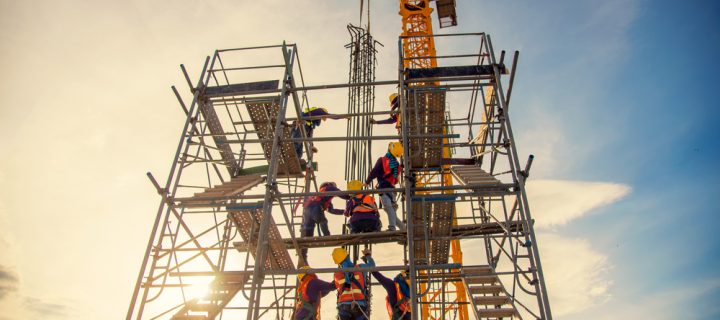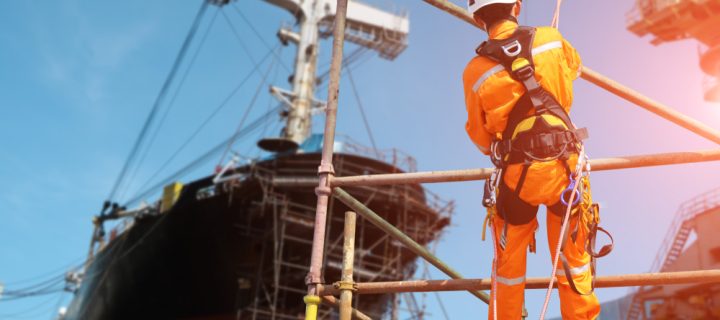When your building is under construction, the premises can be put in a vulnerable position. Therefore, one of the important things is keeping your site as secure as possible. If a site is not secured properly, members of the public or children can gain unauthorised access and risk an injury occurring from falling objects or attempting to climb your scaffolding structure. Another reason you need to keep your site closed off is to prevent vandalism and damage being caused to your site. For those reasons, it is crucial to prevent unauthorised access at all times, not only during the day but also outside of working hours, as these incidents could happen at any time. This may lead you to ask the following question: how do I prevent unauthorised access to my site? Here are 3 effective ways to achieve this. 1) Access Control Implementing access control measures can add an extra layer of security including locked gates or key-coded entry systems. By restricting access to only authorised personnel such as construction workers, you can prevent unauthorised individuals from entering your site. This provides a basic level of security. However, locked gates can be vandalised or climbed over, thus giving unauthorised access so you will need to add additional safety measures to increase the level of security. 2) Carry Out Regular Inspections Regular inspections and monitoring help to detect any signs of unauthorised access and trespassing. This can involve assigning someone or hiring security staff to regularly check the site and scaffolding for any unusual activity. By promptly identifying and addressing any potential breaches, you can ensure the safety and security of your site. Alternatively, installing CCTV cameras around your site can provide you with 24-hour surveillance. With modern technology, the latest CCTV systems allow you to view real time surveillance of your site from a remote computer, tablet or mobile phone. 3) Plastic Hoarding Secure the site by setting up some form of physical barrier around the scaffolding area. These can be sturdy fencing, barricades or plastic hoarding. Plastic hoarding refers to the use of plastic sheets or panels to create a temporary barrier or enclosure. It is commonly used on building and construction sites to separate the work...
Read Moreabout 3 Ways To Prevent Unauthorised Access To Your SiteWorking as a scaffolder is one of the most dangerous jobs in Britain as the chances of falling materials or falling from a significant height yourself is high. According to the 2022 Safety Report by National Access & Scaffolding Confederation (NASC), there were 13 reported falls from height in scaffolding related job roles, nine of which resulted in fractures. Furthermore, the 2017 Safety Report states there were 26 reported falls from height (twice the number in 2022). This means the level of safety has improved significantly in the scaffolding industry over the past few years. Luckily, these accidents can be prevented by effective fall protection systems. In this article, Network Scaffold Services will discuss fall protection systems in more detail. What does this mean for you and your workers? And what are the different types of fall protection systems available? Continue reading to learn more. What Are The Types Of Fall Protection Systems? A fall protection system refers to the safety measures and equipment used when working at height. Appropriate systems must be put in place to ensure the safety for workers in risky situations. There are 2 main types of fall protection systems, these include: Fall Restraint A fall restraint system works by preventing falls and eliminating risk where possible. For example, it prevents workers from getting too close to an edge where they could potentially fall from. A safety harness will allow workers to maintain stability while working hands-free. Guard railings, toe boards and other barricades are other elements of a fall restraint system. However, not all types of work will be suitable for this type of system, as certain jobs may require workers to be positioned in riskier conditions. In this case, a fall arrest system will most likely be needed. Fall Arrest Fall arrest systems are used as a last resort to stop a fall already in the process of happening as well as protecting a worker if they happen to fall. It consists of a safety harness, an anchorage and a connector. An anchor point system is designed to connect the worker to the surface they are working on and used to attach the worker to safety devices such as deceleration devices (designed to...
Read Moreabout What Fall Protection Is Needed For Scaffolding?Scaffolding is an essential part in many industries. Whether your company wishes to undergo construction work or has a renovation project on the horizon, scaffolding has many uses in the business landscape. It provides a safe and stable platform for construction workers to access areas and perform work at height. However, using scaffolding for your business can become a safety hazard for your employees, customers and anyone passing through your building. In this article, we will discuss some ways to keep your business running smoothly whilst using scaffolding. Inform Your Customers And Train Your Staff Before erecting scaffolding, we advise you to inform your employees and customers to ensure they are fully aware of the construction work being done. This includes informing customers on how to safely enter and exit the building, as well as training employees on the safety measures that need to be taken. Securing the outside of the building is just as important. If your building is located near a busy pedestrian street, we advise you to place clear signage outside your building to inform anyone who is passing through to stay clear. These procedures can help prevent the risk of accidents and injuries happening while using scaffolding. Keep The Work Area Clean and Clear It’s important to keep the work area around the scaffolding clean from debris and clear from safety hazards such as tangled cable and extension leads. This will prevent trips or falls while staff or customers pass through the area under construction. Even better, if it is possible to border off the work area until the construction work is completed will help dramatically lower the risk of accidents and injuries. Conduct Regular Safety Inspections Accommodating safety measures is conducting regular safety inspections on the scaffolding structure. Safety inspections should be conducted before it’s used for the first time, every 7 days until it is dismantled and if it was exposed to harsh weather conditions. These safety inspections ensure the scaffolding structure is in good condition and properly secure to prevent any part from tipping over or collapsing in decidedly worse weather conditions. In addition, make sure to check for missing pieces that could pose a safety hazard, as well as checking for...
Read Moreabout How To Keep Your Business Running Smoothly Whilst Using ScaffoldingScaffolding is one of those things you don’t really think about. However, it plays a vital role in some industry sectors in order to complete their goals and projects. Scaffolding can offer easy access, durability, versatility, save time and more for businesses in those industries. In this article, we discuss which industry sectors require scaffolding and what can those sectors use scaffolding for. 1) Construction The number one sector that requires scaffolding is the construction industry. Whether it’s needed for home renovations or large building projects, scaffolding is seen as a standard for most construction companies in the UK. It’s also seen as the safest option for construction workers to access and perform their duties at heights, instead of using a ladder. Scaffolding provides a sturdy platform for workers to carry out their duties while storing their tools and equipment on the scaffold tower. 2) Civil Engineering Similar to construction, the civil engineering industry would require scaffolding to properly inspect and survey projects throughout the process. Having a scaffolding unit allows civil engineers to access and view every aspect of the structure to carry out necessary repairs, maintenance and any audits or checks in a safe manner. 3) Window Cleaning Window cleaning companies may require scaffolding to clean windows when rope access options are not readily available. When it comes to cleaning the windows of high-rise buildings or the exterior windows of large commercial properties, a scaffolding tower is a much safer option for professional window cleaners instead of rope access. They can easily reach their desired height and access the window surface from there. Professional window cleaners can also store their cleaning equipment with them on the scaffold’s platform for convenience. 4) Event Management Event planners and event management companies can use scaffolding units to beautifully decorate venues, sets, theatres or stages. Its sturdy platform is also ideal for the professional installation of screens, speakers and lighting at height. Scaffolding units are a safe and effective way for temporary operations as scaffolding towers can easily be assembled and dismantled for future events. 5) Photography & Film An industry that most people don’t assume needs scaffolding is the photography & film industry. Professional photographers and camera operators may need...
Read Moreabout Which Industry Sectors Require Scaffolding?In recent years, sustainability has become more and more important for businesses. The building and the scaffolding industry may seem to have a negative impact on the environment due to the high usage of heavy-duty machinery, emissions, energy use and the amount of waste in construction sites, however, this initial assessment might not be correct. Can scaffolding be considered sustainable? In this article, we will discuss why scaffolding is more sustainable than you think. Recyclable and Reusable One way of reducing a business’ negative impact on the environment is using recyclable and reusable materials. Made from aluminium or steel, scaffolding poles are strong and durable enough to be reused over and over again. Similarly, metal poles can be melted down to make other products. Aluminium and steel scaffolding poles are also recyclable, as long as they are recycled properly in scrap metal collections or recycling centres, it should have no negative impact on the environment. Uses Less Timber Before the 19th century, scaffolding was generally made from timber. It wasn’t until many decades later that steel materials were first introduced. In modern times, timber is not commonly used as a scaffolding material. As a result, steel scaffolding has reduced the amount of timber used, saving millions of trees from deforestation. Some types of scaffolding may still use timber, but at much smaller quantities than timber scaffolding. Staff Training Lastly, carrying out training about the environment to staff is another reason how the scaffolding industry has become more sustainable. The purpose of these regular staff training is to ensure environmental policies are fully understood and complied with at all times. Training and educating staff on important issues such as recycling and sustainability is extremely effective. As a result, staff will stay up-to-date on how to reduce their carbon footprint as much as possible while at work. Sustainable Scaffolding In The Midlands As a scaffolding company, we are aware that our line of work and those of the construction industry can pose a negative impact on our surrounding environment. We are fully committed to reducing any negative impact our operations may cause in local communities as much as possible. We strive for a healthy balance between satisfying our client’s needs, ensuring...
Read Moreabout How Can Scaffolding Be Considered Sustainable?Scaffolding has been a major part of the construction industry for many centuries. Despite being around for an extremely long time, it remains one of the most beneficial and life-saving structures for construction workers. In this article, we will list the main benefits of access scaffolding for large-scale construction projects. 1) Better and Safer Working Conditions The main benefit of scaffolding is to provide better and safer working conditions at height for construction workers as well as other personnel on-site. It is much safer than using ladders because a scaffold tower is assembled with aluminium plywood decks, stair towers and steel or wooden plank systems, metal poles and fittings to hold the framework efficiently and securely. Ladders can slip and fall easily if not secured in place properly, causing injuries. A scaffold tower is a better alternative because they provide a solid framework for workers with more room to move around. 2) Easy Access Construction work can become more difficult to perform if access to some parts is limited or restricted. Due to the way scaffolding was designed, workers and other personnel get full access to all areas of the building under construction. This is why scaffolding is a great solution as it allows easy access and free movement to move from one part to the next smoothly, no matter how many workers are on the scaffold tower or how tall or large the building is. Not only does it give easy access for construction workers but also for personnel who wish to gain access inside the building. At Network Scaffold Services, our operations take place during quieter times to prevent access restrictions inside your building for you and your workers. 3) Increase Productivity Easy access and better and safer working conditions can lead to increased productivity. A scaffold tower allows construction workers to perform painting and plastering tasks on hard-to-reach areas. Workers can also store tools and materials on the scaffold tower without the hassle of carrying tools and materials up and down ladders. This means scaffolding is a fantastic time-saving structure for large-scale projects. These little improvements can help speed up the overall process of construction work. 4) Durable Scaffold towers can last for a very long...
Read Moreabout The Benefits Of Access Scaffolding For Large-Scale Projects
